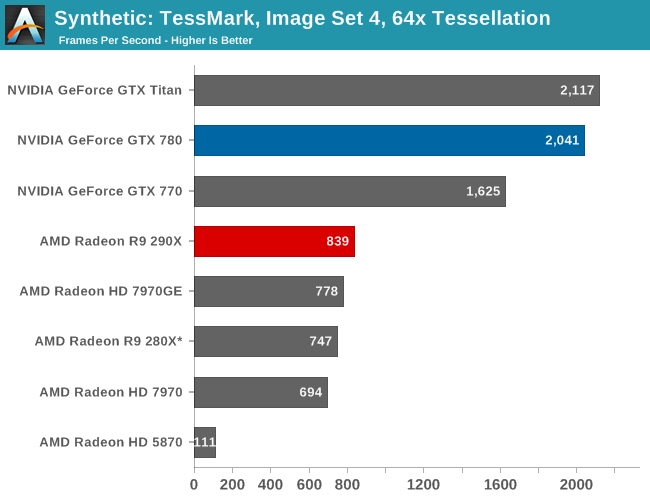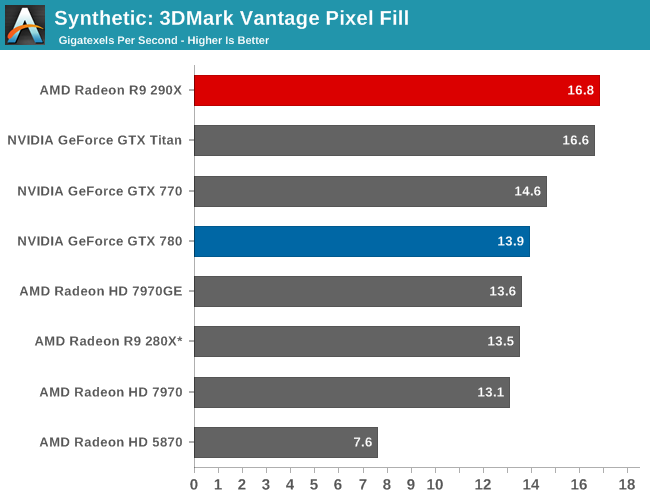The AMD Radeon R9 290X Review
by Ryan Smith on October 24, 2013 12:01 AM EST- Posted in
- GPUs
- AMD
- Radeon
- Hawaii
- Radeon 200
Synthetics
As always we’ll also take a quick look at synthetic performance. The 290X shouldn’t pack any great surprises here since it’s still GCN, and as such bound to the same general rules for efficiency, but we do have the additional geometry processors and additional ROPs to occupy our attention.

Right off the bat then, the TessMark results are something of a head scratcher. Whereas NVIDIA’s performance here has consistently scaled well with the number of SMXes, AMD’s seeing minimal scaling from those additional geometry processors on Hawaii/290X. Clearly Tessmark is striking another bottleneck on 290X beyond simple geometry throughput, though it’s not absolutely clear what that bottleneck is.
This is a tessellation-heavy benchmark as opposed to a simple massive geometry bencehmark, so we may be seeing a tessellation bottleneck rather than a geometry bottleneck, as tessellation requires its own set of heavy lifting to generate the necessary control points. The 12% performance gain is much closer to the 11% memory bandwidth gain than anything else, so it may be that the 280X and 290X are having to go off-chip to store tessellation data (we are after all using a rather extreme factor), in which case it’s a memory bandwidth bottleneck. Real world geometry performance will undoubtedly be better than this – thankfully for AMD this is the pathological tessellation case – but it does serve of a reminder of how much more tessellation performance NVIDIA is able to wring out of Kepler. Though the nearly 8x increase in tessellation performance since 5870 shows that AMD has at least gone a long way in 4 years, and considering the performance in our tessellation enabled games AMD doesn’t seem to be hurting for tessellation performance in the real world right now.
Moving on, we have our 3DMark Vantage texture and pixel fillrate tests, which present our cards with massive amounts of texturing and color blending work. These aren’t results we suggest comparing across different vendors, but they’re good for tracking improvements and changes within a single product family.

Looking first at texturing performance, we can see that texturing performance is essentially scaling 1:1 with what the theoretical numbers say it should. 36% better texturing performance over 280X is exactly in line with the increased number of texture units versus 280X, at the very least proving that 290X isn’t having any trouble feeding the increased number of texture units in this scenario.

Meanwhile for our pixel fill rates the results are a bit more in the middle, reflecting the fact that this test is a mix of ROP bottlenecking and memory bandwidth bottlenecking. Remember, AMD doubled the ROPs versus 280X, but only gave it 11% more memory bandwidth. As a result the ROPs’ ability to perform is going to depend in part on how well color compression works and what can be recycled in the L2 cache, as anything else means a trip to the VRAM and running into those lesser memory bandwidth gains. Though the 290X does get something of a secondary benefit here, which is that unlike the 280X it doesn’t have to go through a memory crossbar and any inefficiencies/overhead it may add, since the number of ROPs and memory controllers is perfectly aligned on Hawaii.










396 Comments
View All Comments
SolMiester - Monday, October 28, 2013 - link
So you can OC a 780 on stock, but not the 290x to sustain the OC, which means 780 wins!, especially after the price drop to $500!, oh dear AMD 290x just went from hero to zero...TheJian - Friday, October 25, 2013 - link
I gave links and named the games previously...See my post. At 1080p 780 trades blows depending on the games. Considering 98.75% of us are 1920x1200 or less, that is important and you get 3 AAA games with 780, on top of the fact that it's using far less watts, less noise and less heat. A simple drop in price of $50-100 and 780 seems like a no brainer to me (disregarding the 780TI which should keep the same price as now I'd guess). Granted Titan needs a dunk in price now too, which I'm sure will come or they'll just replace it with a full SMX up-clocked titan to keep that price. I'm guessing old titan just died as 780TI will likely beat it in nearly everything if the rumored clock speed and extra smx are true. They will have to release a new titan ULTRA or something with another smx or up the mhz to 1ghz or something. OR hopefully BOTH.I'm guessing it's easier to just up the 100mhz or put it to 1ghz as surely manufacturing has gotten them to where all will do this now, more than having all SMX's defect free. Then again if you have a bad SMX just turn a few more off and it's a 780TI anyway. They've had 8 months to either pile up cherry picked ones, or just improve totally anyway so more can do this easily. Clearly 780ti was just waiting in the wings already. They were just waiting to see 290x perf and estimates.
eddieveenstra - Sunday, October 27, 2013 - link
Titan died when 780gtx entered the room at 600 Euro. I'm betting Nvidia only brings a 780gtx ti and that's it. Titan goes EOL.anubis44 - Thursday, October 24, 2013 - link
This is the reference card. It's not loud unless you set it to 'Uber' mode, and even then, HardOCP thought the max fan speed should be set to 100% rather than 55%. Imagine how quiet an Asus Direct CUIII or Gigabyte Windforce or Sapphire Toxic custom cooled R9 290x will be.Crossfire and frame pacing all working, and R9 290X crushes Titan in 4K gaming (read HardOCP's review of this 4K section), all while costing $100 less than GTX780, and the R9 280X (7970) is priced at $299, and the R9 270X (7870) is now going for $180, and now Mantle API could be the next 3dfx Glide, and boost all 7000-series cards and higher dramatically for free...
It's like AMD just pulled out a light sabre and cut nVidia right in half while Jsen Hsun just stares dumbly at them in disbelief. He should have merged nVidia with AMD when he had the chance. Could be too late now.
Shark321 - Thursday, October 24, 2013 - link
There will be no custom cooling solution for the time being. It's the loudest card ever released. Twice as loud as 780/Titan in BF3 after 10 minutes of playing. Also Nvidia will bringt the 780Ti in 3 weeks, a faster cart at a comparable price, but quiet. AMD releases the 290x one year after NVidia, 2 years after NVidias tipeout. Nvidia will be able to counter this with a wink.just4U - Thursday, October 24, 2013 - link
Shark Writes: "It's the loudest card ever released."Guess you weren't around for the Geforce5...
HisDivineOrder - Thursday, October 24, 2013 - link
The FX5800 is not ever dead. Not if we remember the shrill sound of its fans......or if the sound burned itself into our brains for all time.
Samus - Friday, October 25, 2013 - link
I think the 65nm GeForce 280 takes the cake for loudest card ever made. It was the first card with a blower.ninjaquick - Thursday, October 24, 2013 - link
lol, the Ti can only do so much, there is no smaller node for either company to jump to, not until March for enough shipments to have stock for sales. The 290X just proves AMD's GCN design is a keeper. It is getting massively throttled by heat and still manages to pull a slight lead over the titan, at sometimes 15% lower clocks than reference. AMD needed a brand for this release season, and they have it.Both Nvidia and AMD are jumping to the next node in 2014. Nvidia will not release Maxwell on the current node. And there is no other node they would invest in going to.
HisDivineOrder - Thursday, October 24, 2013 - link
The Ti could theoretically open up all the disabled parts of the current GK110 part. Doing that, who knows what might happen? We've yet to see a fully enabled GK110. I suspect that might eat away some of the Titan's efficiency advantage, though.